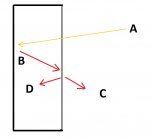There is an intuitive explanation. First, remember that
the second law of thermodynamics is an expression of the universal principle of dissipation of kinetic and potential energy observable in nature. The second law is an observation of the fact that over time, differences in temperature, pressure, and chemical potential tend to even out in a physical system that is isolated from the outside world. Entropy is a measure of how much this process has progressed. The entropy of an isolated system that is not in equilibrium tends to increase over time, approaching a maximum value at equilibrium. In classical thermodynamics, the second law is a basic postulate applicable to any system involving heat energy transfer; in statistical thermodynamics, the second law is a consequence of the assumed randomness of molecular chaos.
In the case of osmosis, you have intead of temperature, a new variable called chemical potential, but it works in a very similar way. Energy will flow towards equilibrium in a way to make the chemical potential at the two sides of a membrane equal. If you have more salt on one side of a membrane that on the other, and the membrane allows water to cross, but not salt, then the water will flow to diminish the density of the salt on the side of larger concentration. The flow will stop when both chemical potentials are the same.
Update: what is chemical potential asked by OP
Particles tend to move from higher chemical potential to lower chemical potential. In this way, chemical potential is a generalization of "potentials" in physics such as gravitational potential. When a ball rolls down a hill, it is moving from a higher gravitational potential (higher elevation) to a lower gravitational potential (lower elevation). In the same way, as molecules move, react, dissolve, melt, etc., they will always tend naturally to go from a higher chemical potential to a lower one, changing the particle number, which is conjugate variable to chemical potential. A simple example is a system of dilute molecules diffusing in a homogeneous environment. In this system, the molecules tend to move from areas with high concentration to low concentration, until eventually the concentration is the same everywhere. The microscopic explanation for this is based in kinetic theory and the random motion of molecules. However, it is simpler to describe the process in terms of chemical potentials: For a given temperature, a molecule has a higher chemical potential in a higher-concentration area, and a lower chemical potential in a low concentration area. Movement of molecules from higher chemical potential to lower chemical potential is accompanied by a release of free energy. Therefore it is a spontaneous process.








